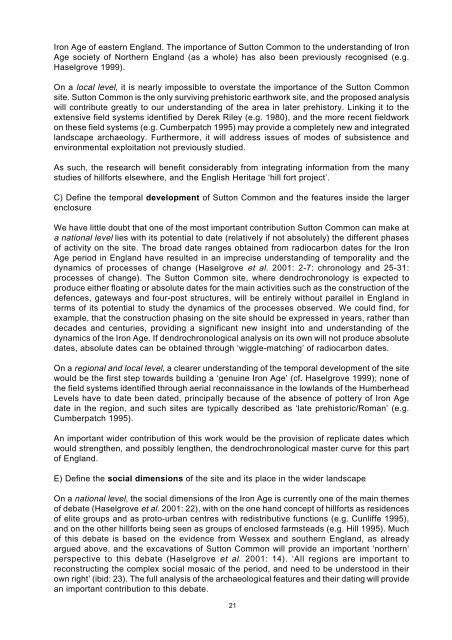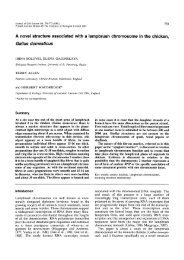Sutton Common Updated project design - University of Exeter
Sutton Common Updated project design - University of Exeter
Sutton Common Updated project design - University of Exeter
Create successful ePaper yourself
Turn your PDF publications into a flip-book with our unique Google optimized e-Paper software.
Iron Age <strong>of</strong> eastern England. The importance <strong>of</strong> <strong>Sutton</strong> <strong>Common</strong> to the understanding <strong>of</strong> Iron<br />
Age society <strong>of</strong> Northern England (as a whole) has also been previously recognised (e.g.<br />
Haselgrove 1999).<br />
On a local level, it is nearly impossible to overstate the importance <strong>of</strong> the <strong>Sutton</strong> <strong>Common</strong><br />
site. <strong>Sutton</strong> <strong>Common</strong> is the only surviving prehistoric earthwork site, and the proposed analysis<br />
will contribute greatly to our understanding <strong>of</strong> the area in later prehistory. Linking it to the<br />
extensive field systems identified by Derek Riley (e.g. 1980), and the more recent fieldwork<br />
on these field systems (e.g. Cumberpatch 1995) may provide a completely new and integrated<br />
landscape archaeology. Furthermore, it will address issues <strong>of</strong> modes <strong>of</strong> subsistence and<br />
environmental exploitation not previously studied.<br />
As such, the research will benefit considerably from integrating information from the many<br />
studies <strong>of</strong> hillforts elsewhere, and the English Heritage ‘hill fort <strong>project</strong>’.<br />
C) Define the temporal development <strong>of</strong> <strong>Sutton</strong> <strong>Common</strong> and the features inside the larger<br />
enclosure<br />
We have little doubt that one <strong>of</strong> the most important contribution <strong>Sutton</strong> <strong>Common</strong> can make at<br />
a national level lies with its potential to date (relatively if not absolutely) the different phases<br />
<strong>of</strong> activity on the site. The broad date ranges obtained from radiocarbon dates for the Iron<br />
Age period in England have resulted in an imprecise understanding <strong>of</strong> temporality and the<br />
dynamics <strong>of</strong> processes <strong>of</strong> change (Haselgrove et al. 2001: 2-7: chronology and 25-31:<br />
processes <strong>of</strong> change). The <strong>Sutton</strong> <strong>Common</strong> site, where dendrochronology is expected to<br />
produce either floating or absolute dates for the main activities such as the construction <strong>of</strong> the<br />
defences, gateways and four-post structures, will be entirely without parallel in England in<br />
terms <strong>of</strong> its potential to study the dynamics <strong>of</strong> the processes observed. We could find, for<br />
example, that the construction phasing on the site should be expressed in years, rather than<br />
decades and centuries, providing a significant new insight into and understanding <strong>of</strong> the<br />
dynamics <strong>of</strong> the Iron Age. If dendrochronological analysis on its own will not produce absolute<br />
dates, absolute dates can be obtained through ‘wiggle-matching’ <strong>of</strong> radiocarbon dates.<br />
On a regional and local level, a clearer understanding <strong>of</strong> the temporal development <strong>of</strong> the site<br />
would be the first step towards building a ‘genuine Iron Age’ (cf. Haselgrove 1999); none <strong>of</strong><br />
the field systems identified through aerial reconnaissance in the lowlands <strong>of</strong> the Humberhead<br />
Levels have to date been dated, principally because <strong>of</strong> the absence <strong>of</strong> pottery <strong>of</strong> Iron Age<br />
date in the region, and such sites are typically described as ‘late prehistoric/Roman’ (e.g.<br />
Cumberpatch 1995).<br />
An important wider contribution <strong>of</strong> this work would be the provision <strong>of</strong> replicate dates which<br />
would strengthen, and possibly lengthen, the dendrochronological master curve for this part<br />
<strong>of</strong> England.<br />
E) Define the social dimensions <strong>of</strong> the site and its place in the wider landscape<br />
On a national level, the social dimensions <strong>of</strong> the Iron Age is currently one <strong>of</strong> the main themes<br />
<strong>of</strong> debate (Haselgrove et al. 2001: 22), with on the one hand concept <strong>of</strong> hillforts as residences<br />
<strong>of</strong> elite groups and as proto-urban centres with redistributive functions (e.g. Cunliffe 1995),<br />
and on the other hillforts being seen as groups <strong>of</strong> enclosed farmsteads (e.g. Hill 1995). Much<br />
<strong>of</strong> this debate is based on the evidence from Wessex and southern England, as already<br />
argued above, and the excavations <strong>of</strong> <strong>Sutton</strong> <strong>Common</strong> will provide an important ‘northern’<br />
perspective to this debate (Haselgrove et al. 2001: 14). ‘All regions are important to<br />
reconstructing the complex social mosaic <strong>of</strong> the period, and need to be understood in their<br />
own right’ (ibid: 23). The full analysis <strong>of</strong> the archaeological features and their dating will provide<br />
an important contribution to this debate.<br />
21
















